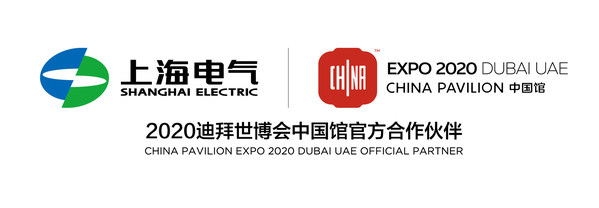Shanghai Electric Signs Agreement to Launch PEM Hydrogen Production Technology R&D Center, Empowering Green Hydrogen Development in China
 |
SHANGHAI, March 16, 2021 /PRNewswire/ — Shanghai Electric (the "Company") (SEHK: 02727, SSE: 601727), the world's leading manufacturer and supplier of electric power generation equipment, industrial equipment, and integration services, joined hands with the Dalian Institute of Chemical Physics of the Chinese Academy of Sciences (the "Dalian Institute") to inaugurate the Proton Exchange Membrane (PEM) Hydrogen Production Technology R&D Center on March 4. The two parties signed a project cooperation agreement on Megawatt Modular and High-Efficiency PEM Hydrogen Production Equipment and System Development, marking an important step forward for Shanghai Electric in the field of hydrogen energy.
As one of China's largest energy equipment manufacturers, Shanghai Electric is at the forefront in the development of green hydrogen as part of China's clean energy drive. During this year's Two Sessions, the 14th Five-Year Plan was actively discussed, in which green hydrogen features prominently. With strong government support and widespread industry interest, 2021 is emerging as Year Zero for the hydrogen energy industry.
Currently, Shanghai Electric and the Dalian Institute have reached a preliminary agreement on the industrial development path for new energy power generation and electrolyzed water hydrogen production. As part of the cooperation, both will also continue to enhance the transformational potential of PEM electrolyzed water hydrogen production, accelerate the development of competitive PEM electrolyzed hydrogen products, and promote industrial applications and scenarios. Moreover, they will continue to carry out in-depth cooperation across the entire hydrogen energy industry chain to accelerate overall industrialization.
Hydrogen energy boasts the biggest potential of all the current forms of clean energy, and the key to its development lies in its production. At present, hydrogen production primarily stems from fossil fuels, industrial by-product hydrogen recovery and purification, and production by water electrolysis. These processes result in significant carbon emissions. The rapid development of PEM water electrolysis equipment worldwide in recent years has enabled current technologies to achieve zero carbon emissions, effectively realizing green, clean hydrogen. This breakthrough will be instrumental in helping China achieve its carbon peak and carbon-neutrality goals.
The market potential for hydrogen production from electrolyzed water is therefore massive. Forecasts indicate that, by 2050, hydrogen energy will account for approximately 10% of China's energy market, with demand reaching 60 million tons and annual output value exceeding RMB 10 trillion. The Hydrogen: Tracking Energy Integration report released by the International Energy Agency in June 2020 notes that the number of global electrolysis hydrogen production projects and installed capacity have both increased significantly, with output skyrocketing from 1 MW in 2010 to more than 25 MW in 2019. Much of the excitement comes from hydrogen's potential to join the ranks of natural gas as an energy resource that plays a pivotal role in international trade, with the possibility of even replacing it one day. In PwC's 2020 The Dawn of Green Hydrogen report, the advisory predicts that experimental hydrogen will reach 530 million tons by mid-century.
Shanghai Electric set its focus on hydrogen energy years ago, given its major potential for growth as one of the new energy technologies of the future and, in particular, its ability to power new energy vehicles. In 2016, the Central Research Institute of Shanghai Electric began to invest in R&D for key fuel cell systems and stack technologies. In 2020, Shanghai Electric's independently-developed fuel cell engine, which boasts a power capacity of 66 kW and can start in cold temperature environments of as low as -30°C, passed the inspection test of the National Motor Vehicle Product Quality Inspection Center. It adopts Shanghai Electric's proprietary hydrogen circulation system, which delivers strong power and impressive endurance, with the potential to replace gasoline and diesel engines in commercial vehicles.
As the technology matures, hydrogen has entered a stage of accelerated industrialization. Shanghai Electric is leveraging the opportunities to propel its development and the green energy transformation. As part of these efforts, Shanghai Electric established a Hydrogen Energy Division in 2020 to further accelerate the development and bring about a new era of green, clean energy.
As one of the largest energy equipment manufacturing companies in China, Shanghai Electric, with its capability for project development, marketing, investment and financing and engineering, procurement and construction (EPC), continues to accelerate the development and innovation of new energy. The Company has a synergistic foundation and resource advantages across the industrial chain from upstream power generation to downstream chemical metallurgy. The combined elements will accelerate the pace of Shanghai Electric's entry into the field of hydrogen production.
Currently, Shanghai Electric has deployed a number of leading green hydrogen integrated energy industry demonstration projects in Ningdong Base, one of China's four modern coal chemical industry demonstration zones. Among them, the Ningdong Energy Base "source-grid-load-storage-hydrogen" project integrates renewable energy generation, energy storage, hydrogen production from electrolysis, and the entire industrial chain of green chemical/metallurgy.
In December 2020, Shanghai Electric inked a cooperation agreement to develop a "source-grid-load-storage-hydrogen" energy project in Otog Front Banner, Inner Mongolia. Equipped with large-scale electrochemical energy storage and hydrogen production equipment, the project will build a massive new energy power generation base and help the region to achieve efficient cold, heat, electricity, steam and hydrogen energy supply.
Related Links :
http://www.shanghai-electric.com









